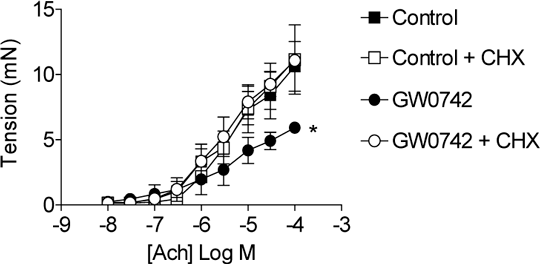Print version
Search Pub Med
Genomic effects of GW0742, a peroxisome proliferator activated receptor (PPAR) β/δ agonist on rat bronchi Peroxisome Proliferator activated receptors (PPARs) are therapeutic targets in the treatment of inflammatory lung disease. We have recently shown that the PPARβ/δ agonist GW0742 relaxes pulmonary, aorta and mesenteric arteries in mice, and has therapeutic benefits in pulmonary hypertension in rats (Harrington et al, 2010). Despite evidence of ubiquitous PPARβ/δ expression relatively little is known about its effects in the airways Male Sprague Dawley rats (200-250g) were killed by cervical dislocation, and the bronchi mounted into isometric wire myographs. Bronchi were contracted with EC80 concentrations of acetylcholine (Ach) and responses to increasing concentrations of GW0742 (10-6 to 10-4M) measured. Some bronchi were incubated for 16 hours with GW0742 (3 × 10-5M) and/or the protein synthesis inhibitor cyclohexamide (CHX; 1.4 × 10-5M) at 37.5°C, before contractions to Ach measured. Rat bronchi did not relax in response to GW0742 given acutely at concentrations up to 10-4M, where 33.4 ± 5.1% SEM relaxation was seen compared to -10.4 ± 2.8% SEM in time controls (n = 4). Overnight incubation (chronic exposure) of airway tissue with 3 × 10-5M GW0742 reduced broncho-contraction in response to Ach (Figure 1) an effect that was prevented by co-incubation with CHX (Figure 1).

Figure 1. Effect of 16hr incubation with GW0742 +/- Cyclohexamide on Acetylcholine induced broncho-contraction. Data shown is mean ± SEM, n = 3; * p<0.05 by two way ANOVA compared to control or GW0742 plus CHX.
These findings suggest that activation of PPARβ/δ and subsequent gene induction/new protein synthesis protects the airways from bronchospasm and may have therapeutic indications in inflammatory lung diseases.
Harrington et al, 2010 PloS ONE 5(3) e9526.
|
|

